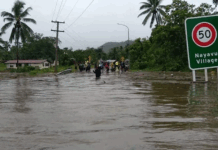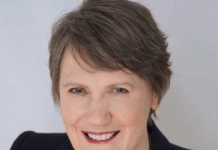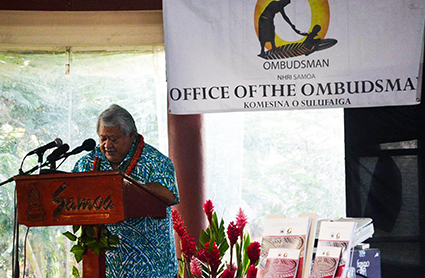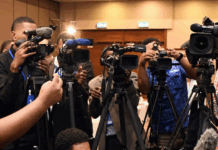Report by Pacific Media Centre
Last week the Samoan Ombudsman launched the country’s first ever State of Human Rights Report. The United Nations hopes the Samoan effort will inspire other Pacific nations to do the same, reports Asia-Pacific Journalism.
Pacific Scoop: Report – By Ida Brock – To Samoa, from Samoa.
Such is the title on Samoa’s State of Human Rights Report, which was launched last week. A report researched and prepared by the Office of the Samoan Ombudsman and the very first of its kind in Samoa.
The report has been well-received, especially by the Office of United Nations’ High Commissioner of Human Rights (OHCHR).
“I think it’s the first time something like this has been done in the Pacific. It’s quite an achievement for what is really a very small office,” says Catherine Phuong, acting head of office of the OHCHR in the Pacific region.
“For the rest of the Pacific, it’s sending a strong signal in terms of the importance of human rights.”
The UN official hopes that the report will make other Pacific nations follow in Samoa’s footsteps and bring violations against human rights to a halt.
“Samoa is showing that even with limited resources, you can achieve something important. I think they are setting quite an example for the rest of the region and I hope it will be followed,” she says.
Benchmark work
rofessor in human rights law Sue Farran from Northumbria University in United Kingdom also thinks there may be a chance, the report will become a benchmark for other Pacific nations’ work with human rights.
“If the Pacific nations see the report as a positive thing, then maybe. But there is often tension between Pacific Islands with them not wanting to be influenced by other Pacific countries. It’s early days and we’ll have to wait and see,” she says.
The Office of the Ombudsman took on the work with the report when it was appointed National Human Rights Institution of Samoa in 2013. The wish was the institution and the report would make a difference to the way human rights was perceived in Samoa.
“We hope that this report will get people to start thinking about the idea of human rights, not as a foreign ideal but as something that has a place in our society,” says the Ombudsman, Maiava Iulai Toma.
But as positive as it is that Samoa has launched its own report on human rights, there is still a long way to go, says Professor Farran.
“There are some areas that has been quite contentious historically. Freedom of the media is one and women’s representation in Parliament is another. Also, domestic violence is an ongoing issue in Samoa,” she says.
The new State of Human Rights Report states, that 39 percent of the Samoans have witnessed abuse against women in their village in the past year. But nonetheless, Samoa is somewhat of a pioneer in the Pacific when it comes to addressing human rights issues, according to Dr Farran.
“Compared to other Pacific nations, Samoa is making quite a good effort.”
Culture and rights clash
The new report outlines a number of vulnerable groups in Samoa: women, children, people with disabilities and prisoners. It also addresses the clash between human rights law and fa’asamoa, meaning “the ways of Samoa”.
“A significant proportion of Samoans consulted believe that human rights and fa’asamoa conflict. This conflict is central to the human rights issues Samoa experiences and unless it’s resolved, the acceptance of human rights in Samoa will continue to be a challenge,” it says in the report.
It’s very common in Pacific constitutions that the rights of the family plays a huge role. It’s a customary right, says professor in human rights law Petra Butler from Victoria University in Wellington.
“In Pacific constitutions the right to practice culture is very explicit. The constitutions are very family oriented and the group is protected,” she says.
And in Samoa the village councils have enormous power over the people, Dr Farran explains. Making the two things meet is a great challenge.
“It’s fine to have countries sign up to international treaties and making new laws, but if it isn’t touching the people directly, it won’t have a lot of significance.
It’s all about making the people understand that human rights are beneficial to everyone and not some sort of post-colonial imposition,” she says.
Action plan
The Office of the Ombudsman has a plan on how to improve the state of human rights in Samoa.
“This report will go hand in hand with a great deal of work around public awareness and continuous educational work,” the Ombudsman says.
And especially education should be a central focus, according to Professor Farran.
“They should teach the children how human rights fit with Samoan values and how human rights are positive for all Samoans. That could have a positive outcome. A lot of societal views are formed early on,” she says.
Besides the need for education, the Office of the Ombudsman provides more than 30 recommendations for action to the Samoan government and NGOs in Samoa. For example it says that the government should “provide dedicated funds and adequate assistance to all NGOs working on the protection of families, especially in rural areas”.
Asia-Pacific Journalism has not got a comment from the Samoan government, but the Prime Minister, Tuilaepa Lupesoliai Sailele Malielegaoi, said when he attended the launch of the report:
“When this report is tabled in Parliament, I ask that time is taken to consider and debate the issues it covers, and that a Parliamentary Committee is tasked with following up on the report’s recommendations.”
According to Catherine Phuong from OHCHR, it sends a strong signal that the Prime Minister attended the launch of the report.
“It shows, they know more needs to be done in terms of human rights protection in the country,” she says.
The Ombudsman is obligated under the Ombudsman Act from 2013 to prepare a periodic State of Human Rights Report to the Samoan Parliament every year.
Ida Brock is a Danish student journalist reporting for the Pacific Media Centre and the Pacific Scoop on the Asia-Pacific Journalism Studies paper.
—












































